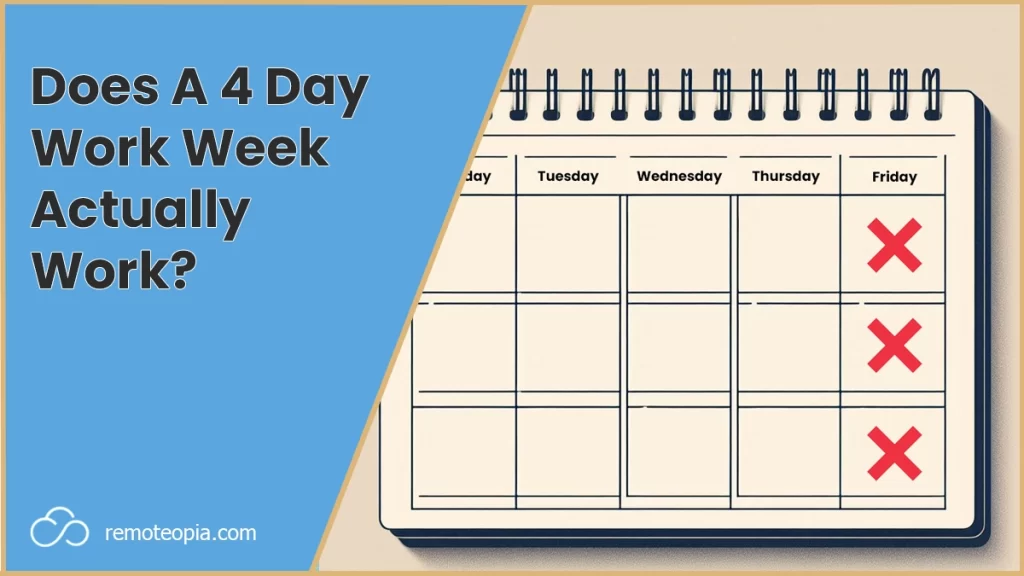
Ahhh the 4 day work week. It’s been a concept for a while now, but never quite made its way into the mainstream.
After Covid and the growth of remote working, there has been more of a focus on employee wellbeing.
The 4 day work week seems like the next logical step in this evolution of work-life balance as more organizations explore ways to improve employee satisfaction and performance while maintaining, or even increasing, productivity.
Key Takeaways:
What Is A Four Day Work Week?
A 4 day work week aims to create a better work-life balance by giving employees an extra day for rest and personal activities; condensing the traditional 40-hour workweek into 32 hours, typically without a reduction in pay.
Recently, US Senator Bernie Sanders, has introduced a bill that proposes an official shift to a four-day workweek, showing the idea is still flirting with implementation at a wider scale.
Benefits Of A 4 Day Work Week
A 4 day work week offers a number of advantages that can lead to a happier and more efficient employees, such as:
Enhanced Productivity
A 4 day work week can lead to a noticeable increase in productivity.
Companies have reported that condensing the work schedule motivates employees to focus and complete tasks more effectively, minimizing time spent on non-work-related activities and reducing workweek fatigue.
Giving workers an extra day off a week actually increases productivity, boosts physical and mental health and reduces CO2 emissions.
World Economic Forum
Improved Employee Well-Being
An extra day off can also contribute significantly to improved employee well-being.
This change has been linked to less workplace stress and burnout, leading to a workforce that feels more rested, happier, and more ready to face the tasks of the work week.
Better Work-Life Balance
Perhaps the biggest factor for employees is the enhanced work-life balance that comes with a 4 day work week.
Allowing for more time spent with family, hobbies, and rest, creating a healthier balance between personal life and professional.
Employee Autonomy
A shorter work week can empower employees, fostering a sense of autonomy as they are given more control over managing their work time and personal time.
This can lead to more self-motivated and self-directed employees who feel trusted and valued by their employer.
Finding 4 Day Work Week Jobs
There are resources and opportunities for finding jobs with a 4 day work week. You can search popular jobs boards for 4 day work weeks:
Challenges Of A 4 Day Work Week
On the other side of the coin, there are a number of considerations that have meant that implementation of a reduced work week hasn’t yet become commonplace.
Shifts In Management And Leadership
For leadership teams, there needs to realign their strategies.
Plans that were initially intended for around 250 days worth of work, need to be condensed into 200.
This often demands a shift towards more trust-based, autonomous styles of management, as employees are empowered to complete their tasks within a compressed timeframe.
Adjustments To Working Structures
Human Resources departments need to undertake significant adjustments in practice to accommodate a four-day workweek.
The changes must support an environment where employees are motivated and efficient during the shortened week, without sacrificing the quality of work or workplace satisfaction.
Companies and employees need to be mindful that the work-life balance benefit doesn’t become skewed for 4 days whereby staff are working extensively longer and harder over the 4 days to cram work in and actually become more burned out.
Implementing a four-day workweek is a balance of maintaining business health while adapting to innovative work models.
Global Perspectives And Case Studies
From experimentation, there’s a number of different countries and companies that offer valuable insights on how this schedule impacts work-life balance and productivity.
What Countries Have A 4 Day Work Week?
Several nations are actively experimenting with or have implemented policies to embrace a shortened work week.
Iceland has run extensive trials resulting in many workers moving to shorter hours.
In the UK 61 UK-based organisations trialed a 4 day work week with the following outcomes:
- 100% of managers and CEOs said the four-day week had a positive or very positive impact on their employees
- 82% reported a positive impact on team wellbeing
- 50% said turnover rates were reduced
- 32% said it improved recruitment.
The Netherlands and Finland have been notable as well for their positive attitudes towards reduced working hours, although these are not yet standardized across the entire country.
What Companies Offer A 4 Day Work Week?
Numerous companies globally have begun offering a four-day work week to improve employee well-being and efficiency.
Microsoft in Japan and Unilever in New Zealand have conducted trials, observing impressive productivity gains and improved employee happiness.
Microsoft’s Japan offices saw a whopping 40% increase in productivity.
Startups and tech companies often lead the charge, while some service and consulting firms have adopted these schedules with success.
Insights from Boston And Cambridge
Academic institutions such as Boston College and the University of Cambridge have conducted in-depth studies on the four-day work week.
These studies often highlight the reduction of stress among employees and examine the unchanged, or even enhanced, productivity levels within organizations that have adopted a four-day work week model.
Implementing The Four-Day Workweek
The transition to a four-day workweek involves strategic planning to ensure flexibility in work options, a well-structured pilot program, and the maintenance of performance and employee satisfaction.
Structuring Flexible Work Options
Flexible work arrangements are pivotal to the success of a four-day workweek.
Employers often consider different models such as a compressed week where employees work longer hours over fewer days, or a reduced-hour schedule maintained at full pay.
Hybrid work models may also be leveraged, allowing employees to split their time between the office and remote work to maximize productivity and personal time.
Running A Pilot Program
The best approach to see if the model works for most companies is to test a pilot program for a set period of time to test the water and potentially tweak any parameters to the structure.
This phase appears crucial as it provides insights into the viability of the new work schedule and allows organizations to test policies in a controlled environment.
During the pilot, clear objectives should be set and data should be collected on various metrics including work output, employee engagement, and operational costs.
Maintaining Performance And Satisfaction
To ensure sustained performance and satisfaction amongst employees, continuous monitoring and adaptation needs to be factored in.
Employers should track productivity levels to verify that the output remains consistent with a traditional workweek.
Regular surveys and feedback sessions can gauge employee satisfaction and identify areas for improvement, ensuring that the benefits of a shortened workweek are fully realized.
Summary
The jury’s still out on the future of the 4 day work week.
Of late, more adoption has come to the fore, which is a promising sign for the future.
It might only be a matter of time before we see more wide scale usage as employee demands dictate the future of their work-life relationship.
Frequently Asked Questions

James Waite
Founder of Remoteopia, James has worked in remote roles for 6 years. After a stint in recruitment, he now works as a director of website strategy in tech.




